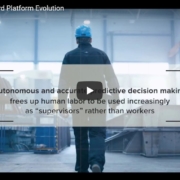Taking a counterintuitive approach to business strategy and technology deployment
As CIOs embrace disruptive technologies, a counterintuitive approach to strategy and execution is key.
As with other disruptive technologies such as augmented/virtual reality, blockchain, drones/UAVs and the Internet of Things, artificial intelligence (AI) has significant potential to transform business models, processes, products and services. According to McKinsey, it’s estimated that AI has the potential to deliver additional global economic activity of around $13 trillion by 2030, or about 16 percent higher cumulative GDP compared with today. This amounts to 1.2 percent additional GDP growth per year.
Along with this growth comes the potential of a growing digital divide in business performance between early adopters and laggards or non-adopters of these emerging technologies. The question is how to get started with exploring technologies like AI for your business and how to quickly navigate from strategy to execution. This learning curve can be somewhat of an issue for CIOs and their teams because according to a recent Gartner survey, 37 percent of organizations are still looking to define their AI strategies, while 35 percent are struggling to identify suitable use cases.
While conventional thinking is often to “get the business strategy sorted out before thinking about technology” and to “focus more on technology during pilot and implementation phases,” counter-intuitively, the reverse is often the best course of action.
In this article, we’ll explore this counter-intuitive approach in more detail with a two-pronged approach of developing the technology-informed business case and then the business-focused technology pilot:
While it’s often popular to stress that “digital transformation is about people not about technology,” the fact is that without technology you just have “transformation” – and even that may be incremental at best since it’s really technology that’s enabling this broader-scale transformation.
Certainly, people and process are vital to execution – i.e. to get the job done – but at its core you need a robust business strategy that incorporates the many advantages that technology can provide. Without the knowledge of the potential of the technology, and how it can be applied for business benefit, the “art of the possible” will remain hidden from executives’ plans.
To ensure your business strategy incorporates the “art of the possible” with technology, be sure to involve appropriate executives who are on point for digital transformation (DX) in your corporate strategic planning processes and committees. This may well be your CIO if she/he is already spear-heading your DX program, or may be another C-level executive such as your CMO or Chief Digital Officer (CDO) depending on how you’re organized. You don’t need to know the inner workings of each technology in question, but a robust understanding of their industry-specific business benefits and use cases will be a powerful asset for strategic planning.
In this way, a technology-informed business case can help to ensure that your digital transformation strategy is your business strategy and vice versa. With so much collaboration and communication required for successful digital transformation initiatives, it’s often hard enough executing on one strategy, let alone two, so this approach should resonate well with all those involved.
Deploy the business-focused technology pilot: deployments should focus first on the business problem and second on the technical solution
Once the case for utilizing AI has been established within your business strategy, it’s important for pilot and production deployments to focus first on the business problem being solved and then second on the technology solution. This helps to avoid the hammer-looking-for-a-nail issue and to focus initial projects on specific pain points or opportunities that can be addressed.
To get to the future vision of fully-digitally-transformed business models and processes, there are two paths: one that consists of small, incremental minimum viable products (MVPs) and pilots and another that consists of a large transformation. While both should help you to arrive at the same end-result, pursuing small, incremental MVPs and pilots can help to generate key learnings early on and deliver some measure of return on investment early on as well. It also enables you to take suitably large or small pivots, as needed, at each step.
To put this into action, look for initial process areas that are candidates for your MVPs and pilots and then deploy to additional process areas as part of your implementation roadmap. While the focus is primarily on learnings and ROI (some advocate aiming for learnings over early ROI, particularly for more complex technologies such as AI and blockchain), these projects will also afford the opportunity to run test drives with vendors and to evaluate their specific technical solutions. Since each MVP and pilot is a small-scale deployment, you can kick the tires on the vendor and their solution in a low-risk environment.
When pursing emerging and disruptive technologies like these, it also helps to focus on powerful combinations of technology and to think about how they can create unique new value propositions for customers and/or unlock far broader productivity gains. As an example, for maximum business benefit many AI projects require a solid automation underpinning to ensure there’s a full spectrum of automation technologies deployed alongside AI to automate and optimize your new and existing business processes as much as possible.
Pursuing a technology-informed business case and business-focused technology pilot
To explore AI for your business, this two-pronged approach of developing the technology-informed business case and then the business-focused technology pilot can be an excellent way to unlock the value of emerging technologies and avoid some of the traditional issues with navigating between strategy and execution.
This approach is particularly beneficial when pursuing strategic technologies which have the potential for transformative business benefits, so can be applied beyond AI, to other strategic technologies such as blockchain and smart contracts and the Internet of Things to name just a few.











